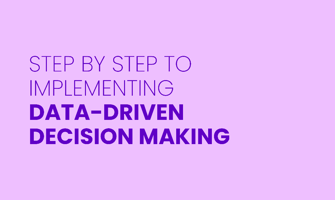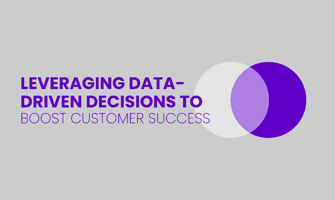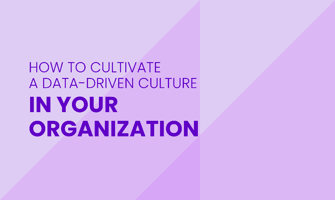Data is the backbone of strategic decision-making in today's businesses. As companies navigate...
Data-Driven Marketing: Tips for Transforming Insights into Action
Data is the backbone of modern marketing strategies.
Understanding and utilizing data effectively allows businesses to make informed decisions that significantly boost marketing effectiveness. From small businesses to large enterprises, embracing a culture where every decision is backed by solid data can transform challenges into opportunities for growth.
By integrating insights derived from thorough data analysis into your marketing strategies, you can enhance both operational outcomes and customer engagement dramatically.
This article aims to equip you with actionable strategies for leveraging data-driven decision making in your marketing operations. Whether it's improving data literacy among your team or mastering the use of big data, these tips will help refine your decision-making processes and increase the overall performance of your marketing teams.
Tip1: Integrate and Centralize Data Sources
Centralizing data from various sources such as social media, CRM systems, and direct customer interactions can significantly enhance your marketing strategy.
By consolidating this information into a single repository, you gain a comprehensive view of your customers. This unified perspective is crucial for developing more targeted and effective marketing campaigns.
A centralized data system improves the ease of access to critical information. It allows marketing teams to quickly retrieve necessary data without sifting through disparate systems. This streamlined access supports faster and more accurate decision-making processes.
The integration process involves combining data from multiple sources while ensuring that the integrity and quality of the information are maintained. High-quality data is essential for reliable analytics which in turn informs strategic decisions that drive business growth.
Benefits include:
Enhanced accessibility to important customer data
Improved analysis capabilities through unified datasets
More informed decision-making based on comprehensive insights
Maintaining high standards of data quality ensures that the insights derived from these analyses are dependable, making them invaluable tools for strategists within your organization aiming to optimize consumer interactions.
Tip2: Use Advanced Analytics and Machine Learning for Marketing Insights
Advanced analytics and machine learning are transforming the way marketing teams operate by enabling them to predict customer behavior, optimize campaign effectiveness, and personalize experiences. These technologies sift through large volumes of data to identify patterns that would be impossible for humans to find manually.
For instance, advanced analytics can process historical purchase data along with real-time consumer interactions. This allows marketers to foresee which products a customer is likely to buy next. Similarly, machine learning algorithms analyze performance metrics from past campaigns to recommend adjustments that could improve future outcomes.
Applying these insights effectively requires integrating them into your existing marketing strategies. Start by segmenting your audience based on predicted behaviors and preferences identified through machine learning models. Then tailor your messaging and offers accordingly to maximize engagement rates.
Additionally, precision marketing becomes more achievable as you refine how you target consumers based on detailed attribution data from various channels.
For example, if analysis shows that customers who watch a particular type of video ad tend to make purchases afterward, you might increase investment in similar content or explore new distribution channels showing potential high returns.
Tip3: Leverage Customer Feedback for Marketing Content
Understanding customer feedback is crucial in shaping effective marketing strategies. By actively listening to your audience, you can tailor content that resonates deeply with their needs and preferences. Here's how you can transform these insights into actionable content strategies.
Firstly, employ various methods to collect feedback effectively. Surveys, social media interactions, and direct customer communications offer rich insights into what your audience truly desires from your brand. Analyzing this data helps pinpoint specific content preferences and pain points across different segments of your target market.
Once you have gathered substantial feedback, the next step involves analyzing this information to uncover underlying patterns and trends. Tools like sentiment analysis or thematic coding can be instrumental here. This analysis will guide you in crafting tailored messages that speak directly to the interests and challenges of your customers.
Finally, apply these insights by developing a segmented content strategy that addresses distinct aspects of the customer journey. Whether it’s educational blog posts for newcomers or detailed case studies for advanced users, ensuring relevance in your messaging is key to boosting engagements.
By integrating customer feedback into your marketing efforts consistently:
You enhance the relevance of each piece.
Strengthen engagements.
Improve overall effectiveness of communication channels.
Remembering always that every piece of content should work towards enhancing the understanding between you and your customers while addressing their specific needs effectively through targeted segmentation strategies.
![]()
Tip4: Utilize Sentiment Analysis to Measure Social Media Campaign Success
Sentiment analysis is a powerful tool that examines the emotions behind customer communications on social media.
By understanding these sentiments, you can gauge how your audience feels about your brand and campaigns. This insight is crucial for tailoring future marketing efforts to better meet the emotional needs of your customers.
One major benefit of sentiment analysis is its ability to provide immediate feedback on campaign performance. For instance, if a new product launch receives predominantly positive sentiments, it's clear that the campaign resonates well with the target audience. Conversely, negative feedback can help identify areas for improvement quickly.
To effectively use sentiment analysis in your marketing strategy:
Monitor real-time reactions and adjust campaigns accordingly.
Analyze trends over time to understand long-term changes in customer attitudes.
Compare sentiment across different platforms to get a holistic view of public perception.
By integrating these strategies into your social media planning, you enhance not only engagement but also the overall customer experience. This approach ensures that each campaign builds positively on previous ones, continuously improving how audiences perceive and interact with your brand.
Tip5: Experiment with Data-Driven Content Creation
Data-driven content creation involves using insights gathered from data analysis to tailor your content strategy. This approach ensures that the topics, formats, and distribution channels you choose are aligned with what your audience truly engages with.
When you start by analyzing market research, page views, and advertising budget allocations, you gain a clear picture of what works. For instance, if data shows that video content on social media drives more engagement for your brand than blog posts do, it's wise to shift focus accordingly.
The process includes several steps:
Collecting relevant data.
Analyzing this data to identify trends and preferences.
Developing content based on these insights.
Distributing the content through the most effective channels.
Measuring the performance of this content in terms of engagement and ROI.
Testing different strategies is crucial here; not every insight will lead directly to success until tested in real-world scenarios. A/B testing can be particularly useful—comparing two versions of a campaign to see which performs better can provide actionable feedback that refines future efforts.
By continuously iterating on this process based on new data collected from each campaign iteration or consumer interaction point (like social media comments or direct feedback), marketing teams can enhance their effectiveness over time while staying responsive to changing consumer behaviors and preferences.
Tip6: Engage in Micro-Moment Marketing
Micro-moments are critical touchpoints within the consumer journey.
They often occur when people reflexively turn to a device—increasingly a smartphone—to act on a need to learn something, do something, discover something, watch something, or buy something. Understanding these moments is crucial for tailoring marketing strategies that connect more effectively with consumers.
To capitalize on micro-moments using data-driven insights involves several steps:
Identify: Use analytics tools to track when and where potential customers engage most frequently and what type of content captures their attention during these windows.
Capitalize: Once you know when your audience is most receptive, tailor your messages to fit into the context of their current needs or desires.
Optimize: Continuously refine your approach based on performance metrics from past interactions to better meet the needs of future engagements.
For example, if data shows that significant user interaction happens on mobile devices during early morning hours for quick breakfast recipes, then targeting this specific time with easy recipe videos can capture attention efficiently.
Effective use of micro-moment marketing not only enhances engagement but also ensures that each interaction is as relevant and impactful as possible by leveraging real-time data insights from mobile technology.
This strategy requires marketers to be agile and responsive—a virtual war room mentality where decisions are swiftly made based on incoming data about consumer behavior patterns.
By integrating micro-moment strategies into broader marketing campaigns, companies can create more personalized experiences that resonate deeply with consumers' immediate needs and interests.
Conclusion
We've taken a close look at the power of data-driven marketing. By integrating big data into your marketing operations, you can transform raw information into transformative insights that fuel more effective strategies.
Remember, using data to guide your decisions isn't just about understanding your market and customers better. It's also about improving the impact of every dollar spent on advertising and customer engagement. The tips we've discussed offer practical ways to leverage big data for significant enhancements in your marketing efforts.
Embracing a culture of data-driven decision making is not an overnight process but a commitment towards continuous improvement and gaining competitive advantage.
FAQ
What is data driven marketing and what are its key benefits?
Data-driven marketing refers to the strategy of leveraging big data, collected through consumer interactions and engagements, to guide marketing decisions. Key benefits include enhanced customer personalization, more efficient spending, improved customer retention, and the ability to more accurately predict marketing trends and consumer behaviors.
What are the most effective marketing analytics techniques for data-driven decision making?
Effective marketing analytics techniques include predictive analytics, which forecasts future trends; segmentation analysis, which divides customers into specific groups based on behavior and preferences; and conversion optimization, which uses A/B testing and other methods to improve the conversion rates of marketing campaigns.
What are the different types of data analysis techniques used in marketing?
Common data analysis techniques used in marketing include descriptive analytics (summarizing past data to identify patterns), predictive analytics (using historical data to forecast future outcomes), prescriptive analytics (suggesting actions based on data), and diagnostic analytics (determining why something happened).
Can you provide examples of media mix optimization in action?
Media mix optimization might involve adjusting advertising spend across various channels to maximize ROI. For instance, a company might shift more budget into social media ads after analytics show higher engagement and conversion rates there compared to traditional TV ads.
What is attribution in data-driven marketing, and why is it important?
Attribution in data-driven marketing involves identifying which marketing tactics or touchpoints contribute to achieving specific business outcomes, like a sale or a lead conversion. It's important because it helps marketers understand which actions are most effective at driving customer actions, thereby enabling better allocation of resources and more tailored marketing strategies.




